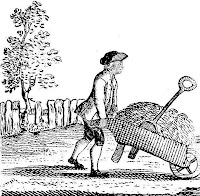A wood is a collection of trees growing more or less thickley together, of considerable extent, usually larger than a grove or copse (but including these), and smaller than a forest. In colonial America wood referred to a piece of ground covered with trees, with or without undergrowth.
In the 16th century, a wood in a pleasure ground was described in J. Manwood's Lawes Forest as a place "Where the trees do grow scattering her and there one, so that those trees do not one of them touch an other."

In 1762, Hannah Callender wrote in her diary of William Peters' Belmont near Philadelphia, Pennsylvania, "We left the garden for a wood cut into vistas. In the midst is a Chinese temple for a summer house. One avenue gives a fine prospect of the city...Another avenue looks to the obelisk."
New Yorker John Nicholson emphasized the practical use of a woodland in The Farmer's Assistant in 1820, every plantation or farm "ought to have a piece of woodland, or forest, sufficient for fuel and other purposes. Raising timber, for the purpose of fencing, will not often be found advisable. Farmers must eventually depend on waking stone walls, or hedges, for the purpose of enclosing their lands.
"But wood and timber sufficient for fuel, for building, for carriages and implements of farming, cannot be dispensed with. Of these, the Farmer will always find it most advantageous to keep the requisite stock himself, and not rely on others for purchasing it. Nor is it advisable to have his woodlands separate, and at a considerable distance from his farm; unless it be in parts of the country where part of the lands are too valuable to be kept in wood, and other adjacent parts are only fit for that purpose.
"When the Farmer is clearing up his farm, he ought to reserve, for woodland, that part which is least adapted for tillage, or for grass. Land which is swampy with a thin soil over a sandy bottom; that is rocky and hilly; or that is dry, poor, or very gravelly, may do well for woodland; while it would answer but indifferently for tillage.
"The quantity of ground to be set apart for this purpose must depend on the size of the farm; the quality of the soil of the woodland; the nature of the climate; and, frequently, according to the demand or market for wood; for, in some cases, it may be found more profitable to keep tolerably good land in wood, than in any other cultivation.
"Of the natural growth of wood, it will require as much as twenty acres, or more, to keep two fires, according to the common method of using wood for fuel."
.





